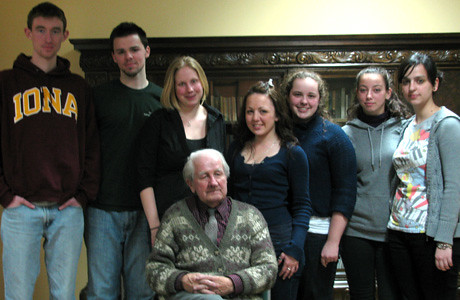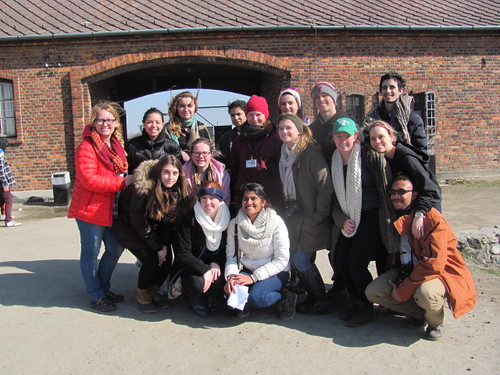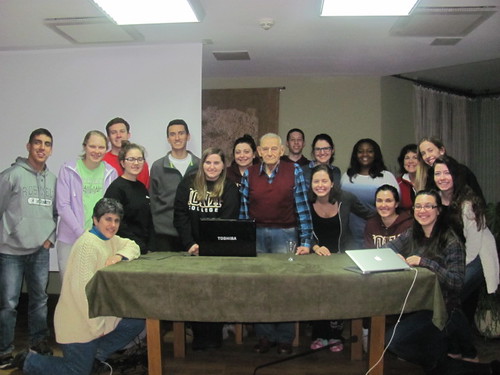We arrived in Poland on Saturday, March 16th. Once settled in, our group received a tour of our home for the next week, The Centre for Prayer and Dialogue; a Catholic center dedicated to open and honest dialogue of people from all perspectives. The Centre was started in the hopes of fostering positive relations between groups healing from the Shoah by providing a place of comfort and respect where all are welcome.
On the tour I noticed a lot of tree imagery in the Centre, which immediately reminded me of the tree of Life Synagogue in Pittsburg which was brutally attacked. It remined me of why we were here, which was bigger than learning about the history of the ground. We are here to be witnesses, to be able to educate others so this evil is never seen again. When Stan Ronell came to speak to our class about his story, I was stuck by his sense of duty. He was made it his mission to sharing his story to make others a witness. He spoke to the importance of witnessing and urged us to take action. He was adamant about the education of young people about the Holocaust so that we do not forget or become bystanders.
I kept the image of the tree in the forefront of my mind, reminding me of our purpose while trying to find other meanings. Why had the Centre chosen this imagery? It had been chosen long before the connection I made was possible. Stan’s message of education was recalled through seeing this image and made me begin to question my own education about the Holocaust. Had I been taught enough? Were we really the heroes of the war we thought we were?
On Monday, we took our first tour of Auschwitz I. As a part of the museum, there is a room with children’s drawings placed around the room. I came across this drawing of a tree and felt a deep immediate connect to it, making the whole experience sink in. The tree, to me, became a symbol of strength and resilience, which suits the Jewish community well. I have always admired the strength and resilience of the Ancient Jewish people, and now here, under the deepest torture and victimization- still strong and resilient.
After being moved by this image, I did some research to the significance of the tree in Judaism. The tree symbolizes God’s creation and many times throughout the Torah, trees are compared to people. There are many lines from scripture that make this connection, including, “For as the days of a tree shall be the days of my people” (Isaiah 65:22). Once again, instilling the strength and resilience of the Jewish people in the image of a tree, by comparing days of a tree, which could be endless to the days of the people. There is also an important holiday in Judaism surrounding the tree called Tu B’Shvat, which is the new year for the tree. This marks the occasion of trees producing sap instead of taking up water. It is a time for growth for the Jewish people, to grow stronger roots and more resilient branches (Rabbi Shraga Simmons, aish.com).
Throughout our group’s experience in the camps of Auschwitz, I came across a book entitled Hana’s Suitcase, a story of a women from Tokyo dedicated to educating children about the Holocaust. Her mission is similar to Stan Ronell’s, which is to provide education to promote tolerance, respect, compassion, and to encourage others to step up and not become a bystander; all in an effort to never allow an event like the Holocaust to happen again. Throughout her journey trying to provide educational tools for children to understand an event that happened far away from them to a population they may not have encountered before, Fumiko Ishioka tried to get an artifact that belonged to a child donated to their small museum about the Holocaust in Tokyo. The Auschwitz Museum donated some artifacts, among them a suitcase belonging to a girl named Hana Brady. While flipping through this book, I recognized a drawing. While uncovering Hana’s story, some of her drawings were discovered in in the concentration camp Theresienstadt. One of these drawings was the tree from the museum.
Hana’s story has a sad ending, having spent two years at Theresienstadt and then transported in 1944 to Auschwitz where she was selected to die upon arrival. Hana had an older brother, George, who was also transported to Auschwitz, however was processed into the camp for work and survived. Ishioka was able to get in contact with George Brady, who shared stories, photos and information about Hana. George visited Japan to meet with the children that were so dedicated to teaching others about the Holocaust. They prepared poems and art for him in Hana’s honor. Their work to expand education about the Holocaust was more successful with more information about Hana. The children wrote a poem memorizing Hana which stated, “We, Small Wings, will tell every child in Japan what happened to Hana. / We, Small Wings, will never forget what happened to one-and-a-half-million Jewish children. / We children can make a difference in building peace in the world- so that the Holocaust will never happen again” (Levine, Hana’s Suitcase, pp. 106) George was overwhelmed with their work and moved by the fact that Hana’s dream of becoming a teacher had become true through her memory. Through Hana’s story, education about the Holocaust is being continued around the world, making sure that this brutality cannot happen again. This experience and connection has inspired me to a commitment to further education for myself and to the best education of children.
On the tour I noticed a lot of tree imagery in the Centre, which immediately reminded me of the tree of Life Synagogue in Pittsburg which was brutally attacked. It remined me of why we were here, which was bigger than learning about the history of the ground. We are here to be witnesses, to be able to educate others so this evil is never seen again. When Stan Ronell came to speak to our class about his story, I was stuck by his sense of duty. He was made it his mission to sharing his story to make others a witness. He spoke to the importance of witnessing and urged us to take action. He was adamant about the education of young people about the Holocaust so that we do not forget or become bystanders.
I kept the image of the tree in the forefront of my mind, reminding me of our purpose while trying to find other meanings. Why had the Centre chosen this imagery? It had been chosen long before the connection I made was possible. Stan’s message of education was recalled through seeing this image and made me begin to question my own education about the Holocaust. Had I been taught enough? Were we really the heroes of the war we thought we were?
On Monday, we took our first tour of Auschwitz I. As a part of the museum, there is a room with children’s drawings placed around the room. I came across this drawing of a tree and felt a deep immediate connect to it, making the whole experience sink in. The tree, to me, became a symbol of strength and resilience, which suits the Jewish community well. I have always admired the strength and resilience of the Ancient Jewish people, and now here, under the deepest torture and victimization- still strong and resilient.
 |
After being moved by this image, I did some research to the significance of the tree in Judaism. The tree symbolizes God’s creation and many times throughout the Torah, trees are compared to people. There are many lines from scripture that make this connection, including, “For as the days of a tree shall be the days of my people” (Isaiah 65:22). Once again, instilling the strength and resilience of the Jewish people in the image of a tree, by comparing days of a tree, which could be endless to the days of the people. There is also an important holiday in Judaism surrounding the tree called Tu B’Shvat, which is the new year for the tree. This marks the occasion of trees producing sap instead of taking up water. It is a time for growth for the Jewish people, to grow stronger roots and more resilient branches (Rabbi Shraga Simmons, aish.com).
 |
 |
|
Hana
Brady’s drawing of a tree on display in the Yah Vashem exhibit at Aushwitz I
|
Hana’s story has a sad ending, having spent two years at Theresienstadt and then transported in 1944 to Auschwitz where she was selected to die upon arrival. Hana had an older brother, George, who was also transported to Auschwitz, however was processed into the camp for work and survived. Ishioka was able to get in contact with George Brady, who shared stories, photos and information about Hana. George visited Japan to meet with the children that were so dedicated to teaching others about the Holocaust. They prepared poems and art for him in Hana’s honor. Their work to expand education about the Holocaust was more successful with more information about Hana. The children wrote a poem memorizing Hana which stated, “We, Small Wings, will tell every child in Japan what happened to Hana. / We, Small Wings, will never forget what happened to one-and-a-half-million Jewish children. / We children can make a difference in building peace in the world- so that the Holocaust will never happen again” (Levine, Hana’s Suitcase, pp. 106) George was overwhelmed with their work and moved by the fact that Hana’s dream of becoming a teacher had become true through her memory. Through Hana’s story, education about the Holocaust is being continued around the world, making sure that this brutality cannot happen again. This experience and connection has inspired me to a commitment to further education for myself and to the best education of children.
































